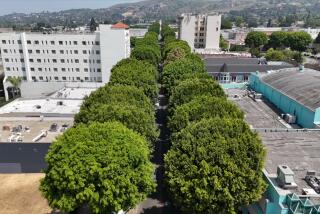NEWPORT BEACH : Tree Full of Blue Herons Threatened?
Last year, a pair of great blue herons made their nest in a tall torrey pine on exclusive Harbor Island. This year, more joined them, establishing a rookery, or community, in the tree.
The birds--3 to 4 feet tall with a 6-foot wingspan when fully grown--swoop down between yachts in Newport Harbor as they hunt for fish, bringing their prey back to feed their young in the tall tree.
Below the pine, one of the oldest on the island, lies a blanket of white droppings on a carpet of brown pine needles. The air echoes with the noisy cackling of the birds. Residents have grown used to the sound and the sight of the birds gracefully soaring through the sky. They occasionally find half-eaten fish in their back yards.
But now some residents are worried that plans may be brewing to remove the tree and build on the vacant lot where it now stands.
“I counted seven nests in the tree, and yesterday, along the top of the tree, you could see five birds, flapping their wings, and with those long, graceful necks, they’re just beautiful,” said Judy Frutig, who lives across the channel from the rookery. “To have birds like that in Newport Beach, it’s the kind of thing you want to see stay.”
Although the lot has been vacant for many years and Newport Beach officials say no plans have been submitted for the property, rumors of plans to remove the tree have spread through the close-knit neighborhood.
“I would like to see the tree remain, but I also think that when people spend a bundle on property, they should be able to do what they want with it,” said Henry Schaefer, who lives a couple of doors down from the vacant lot. Schaefer said the birds are noisy but nothing in comparison to the jetliners from John Wayne Airport that land and take off overhead.
Frutig and others say they want to preserve a bit of nature in an environment of busy freeways and noisy airplanes. “There are a number of people around here who are in awe of the beauty and grace of the bird, and the people I talked to figure that as humans, we have a responsibility to preserve the birds,” Frutig said.
A local newspaper reported that the property is in escrow and neighbors said they have heard that the new owner plans to put a swimming pool where the tree now stands.
Shirley Harris, a real estate broker representing owner William Foote, said the property is not in escrow. She declined further comment.
Although the tall, graceful birds are not endangered or threatened, they are covered by the Migratory Bird Treaty Act, which protects them from hunting, taking, capture, killing or possession, said Kim Gould, a wildlife biologist with the U.S. Fish and Wildlife Service.
Gould said that the act was originally designed to protect hunted waterfowl species but has in recent years been expanded to include all migratory birds. The protection extends to the birds’ habitat, specifically nests, as long as the nests are active, she said.
Great blue herons are migratory, but some are present in the area all year, Gould said. Breeding season for herons is generally mid-April to mid-September.
“Legally, we’d have to see the specific site conditions during the non-breeding season to determine whether cutting down the tree would be a violation of the act,” she explained.
Audubon Society officials have also indicated an interest in monitoring the site and possibly helping to champion the birds’ cause if necessary.
“There’s not many heron rookeries left in Orange County,” said Pete DeSimone, conservation director of the Audubon Sea & Sage chapter.
More to Read
Sign up for Essential California
The most important California stories and recommendations in your inbox every morning.
You may occasionally receive promotional content from the Los Angeles Times.










